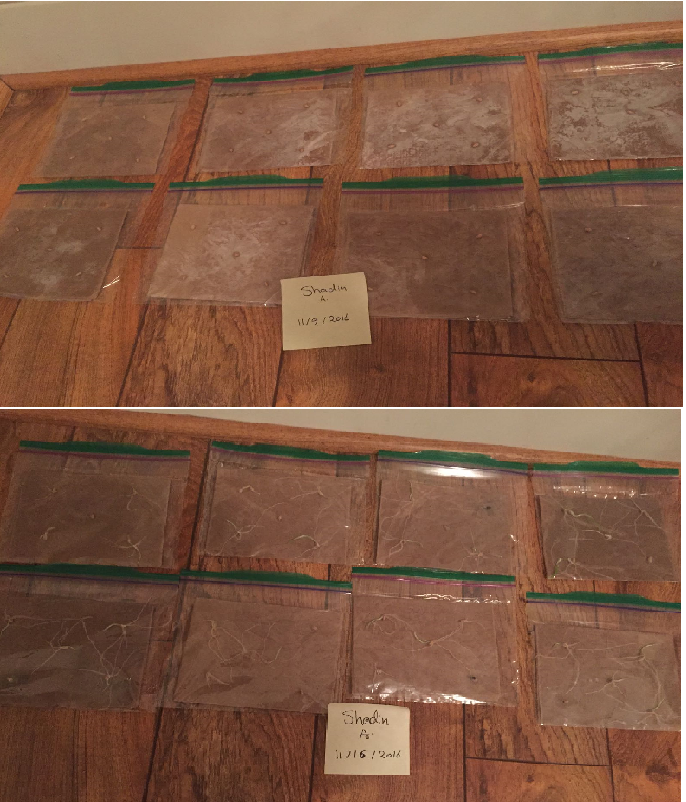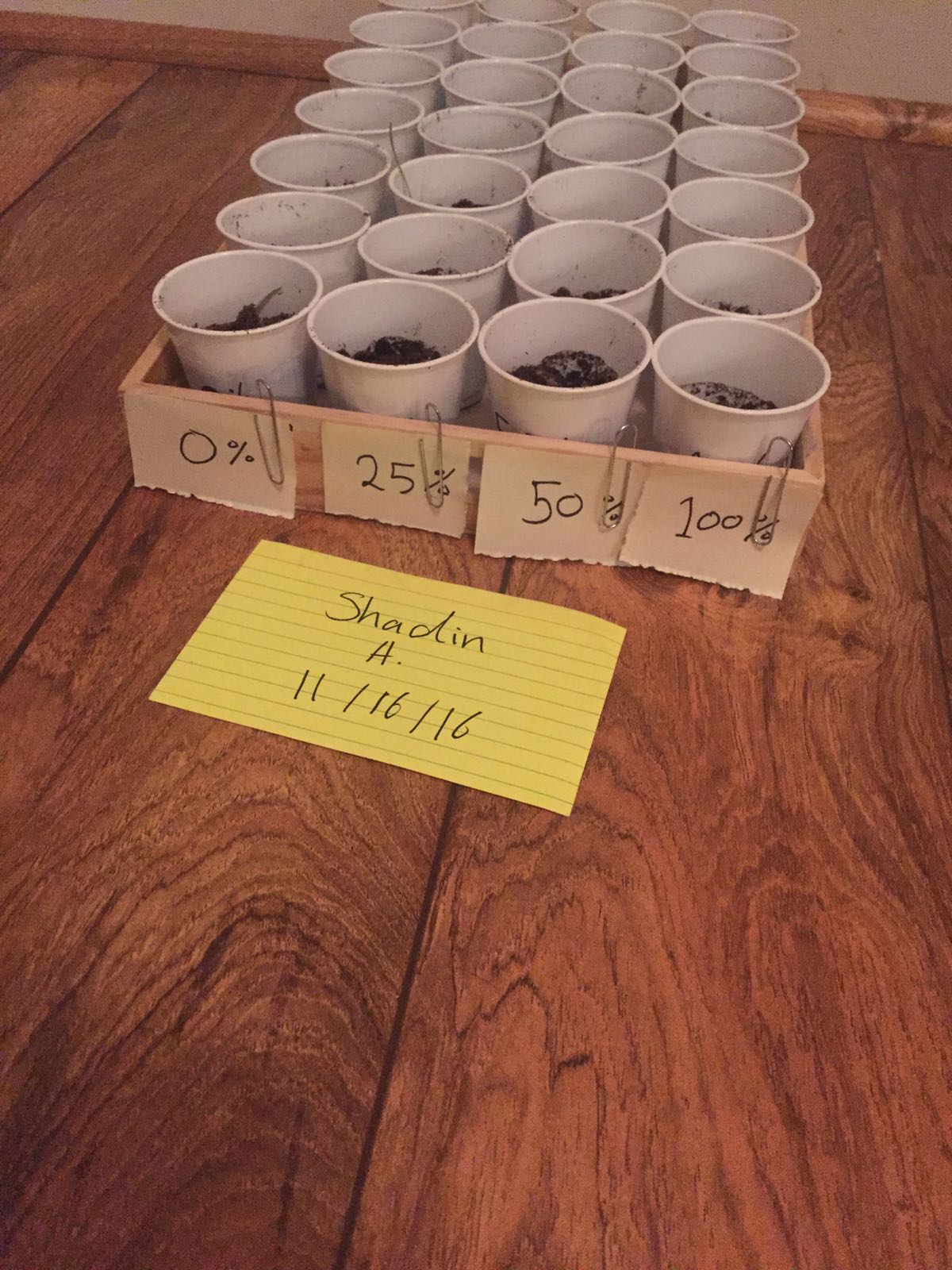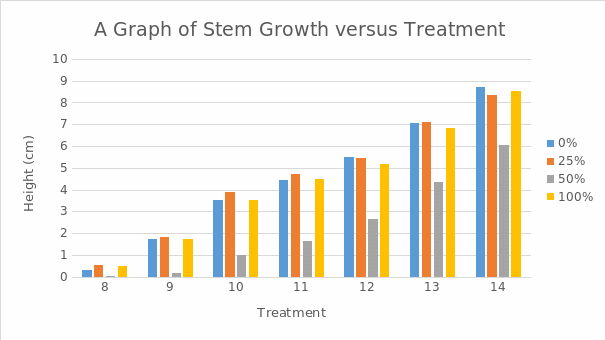Abstract
The healthy growth of plants requires the availability of water, nutrients, and sunlight. This experiment tested the impact of water quality on the growth of plants by using different concentrations of the James River water on potted wheat seedlings. The highest growth rates were realized in the plants treated with 0%, 25%, and 100% river water. The lowest growth rate was observed in the 50% treatment. It was observed that the river water did not have a substantial impact on the growth of the plants, which could be attributed to the positive effects of certain nutrients and microorganisms that were present in the river water.
Introduction
Three vital factors are required for the healthy growth of plants. They include water, sunlight and the availability of nutrients (Kim et al., 2012). Water is necessary for all stages of plant growth and development. In the initial stages of plant growth (the germination process), it activates hydrolytic enzymes stored in the cotyledons of seeds and breaks the seed coat to permit the emergence of the root and shoot of the germinating seed. Water is also needed for photosynthesis where it combines with carbon dioxide from the air in the presence of light energy to carbohydrates, which is the major source of plant food. The uptake of water in the plant cell provides turgor pressure that anchors the plants.
Changing the quality of these plant resources is likely to affect the growth of the plants. The quality of water can be determined by measuring the chemical composition of naturally occurring water such as river water through analytical methods. The quality of water may be altered manually by the addition of different chemicals in varying proportions. Determining the impact of water quality on plant growth needs to be done in such a way that the other two growth factors (light and nutrients) are kept constant.
James River is the largest river in the state of Virginia. It flows throughout the state covering an area of approximately 10,000 square miles (James River Association, 2016a). Its length is approximately 340 miles. The river receives water from tributaries that make up 15,000 miles. The James River hosts the world’s largest and busiest harbor at Norfolk as well as a roosting area for Bald Eagles. The residents of the state of Virginia enjoy water sports such as rafting, biking and hiking also occur in the river. These activities expose the water to various external substances that affect its quality. A recent assessment report reveals that many portions of the river’s tributaries are impaired because of a vast number of pathogenic bacteria (Balazik, Garman, Van Eenennaam, Mohler, & Woods, 2012). Therefore, those areas may not be safe for recreation activities. The 2015 report card reveals that the overall health of the river is at 61% (grade B-) (James River Association, 2016b). The health of fish and wildlife had a score of scored 56%. These findings imply that water from the river may not be entirely safe for plant growth.
Research Objective
The goal of the experiment was to determine the impact of varying concentrations of the James River water on the growth of wheat seeds.
Hypothesis
It was hypothesized that the addition of water from the James River would affect the growth and development of wheat seeds. Therefore, the primary null hypothesis was that here were no significant differences in the average measurements among groups.
Methods
- About 40 wheat seeds were planted in Ziploc bags for a week and allowed to germinate. Out of the 40 seeds, 30 seeds were healthy and suitable for use in the second phase of the experiment, whereas 10 seeds were rotten as indicated in Figure 1.
- 28 of the healthy seedlings were transferred into 28 pots containing soil. The pots were divided into 4 groups each corresponding to different treatment concentrations of 0% (negative control), 25%, 50%, and 100% as shown in Figure 2.
- The river water was diluted into varying concentrations of 25%, 50% and 100% such that the percentages corresponded to the proportion of the river water in pure distilled water. The water was added to the corresponding plants at the beginning of the second week only. Thereafter, a tablespoon of pure water was added to each of the pots every day to keep the soil moist.
- The seedlings were observed for growth characteristics such as the length of stems (in cm), the absorption of water, and the root characteristics.
- Kruskal-Wallis test was done to determine whether the differences among the treatment groups were statistically significant.
Results



The rate of growth was increased as the days progressed. Overall, the highest rate of growth was seen in the controls (0%) followed by 25% and 100% treatment solutions as shown in Figure 3. The lowest rate of growth was observed in plants with 50% of the treatment solution. Water absorption was best at 25% treatment solution. The emergence of roots from the surface of the soil was observed in two, three, and two plants in the 0, 25 and 100% treatment solutions respectively. The Kruskal-Wallis test findings resulted in a chi-squared value of 2.313 at 3 degrees of freedom and a p-value of 0.51. The p-value was greater than α (0.05). Therefore, the study failed to reject the null hypothesis and concluded that the treatment had no significant effect on the growth of the plants.
Discussion
Healthy plant growth was observed in the negative controls (0% river water), 25% and 100% solutions. These findings did not fully support the hypothesis that the James River water would affect the growth of wheat plants. These observations could be attributed to the presence of certain nutrients required for plant growth in the water. Such nutrients include phosphorus and nitrogen from industrial wastewater and agricultural activities because the river is reported to receive water from tributaries associated with industries and agricultural farm. The river is also reported to harbor numerous bacteria. Liu, Xing, Ma, Du, and Ma (2013) report that some rhizobacteria augment the water and nutrient uptake of plants thus improving their growth, which could explain the high growth rates at 100% treatment solution. The lowest rate of growth was realized in the 50% treatment solution. However, it is difficult to account for this observation without finding the precise chemical composition of the water. Other factors that could have affected plant growth such as temperature, sunlight and nutrients were kept constant as the plants were grown under the same conditions. The amount of water was kept constant throughout the experiment by the daily addition of a tablespoon of water to all the plants. Nevertheless, despite the reduced growth in the 50% river water, the Kruskal-Wallis test revealed that the treatments were not statistically different. Therefore, it was concluded that the James River water did not have a substantial impact on plant growth.
The most important water quality indicators are alkalinity, pH and the concentration of soluble salts. The presence of heavy metals in irrigation water also needs to be determined. Such tests are necessary to determine the suitability of the James River water for large scale irrigation purposes. Using poor quality water for irrigation leads to slow plant growth and mediocre aesthetic quality of the crop. In extreme conditions, polluted water may cause the slow but sure death of plants. High concentrations of soluble salts can cause direct damage to roots thereby getting in the way of water and nutrient uptake. Salts also tend to build up in the margins of leaves leading to the etching of leaf margins. Water alkalinity can alter the pH of the soil affecting the intake of nutrients leading to nutrient deficiencies that slow down plant growth and affect the overall health. The impact of pH is often magnified in potted plants because the small amounts of soil have a reduced buffering capacity to resist changes in pH.
Future experiments could look into the precise chemical constituents of the James River water to determine their impact on plant growth. Further tests could also be done to find out why the 50% treatment led to a low rate of growth.
References
Balazik, M. T., Garman, G. C., Van Eenennaam, J. P., Mohler, J., & Woods III, L. C. (2012). Empirical evidence of fall spawning by Atlantic Sturgeon in the James River, Virginia. Transactions of the American Fisheries Society, 141(6), 1465-1471.
James River Association. (2016a). About the James River. Web.
James River Association. (2016b). State of the James. Web.
Kim, S., Rayburn, A. L., Voigt, T., Parrish, A., & Lee, D. K. (2012). Salinity effects on germination and plant growth of prairie cordgrass and switchgrass. Bioenergy Research, 5(1), 225-235.
Liu, F., Xing, S., Ma, H., Du, Z., & Ma, B. (2013). Plant growth-promoting rhizobacteria affect the growth and nutrient uptake of Fraxinus americana container seedlings. Applied Microbiology and Biotechnology, 97(10), 4617-4625.

